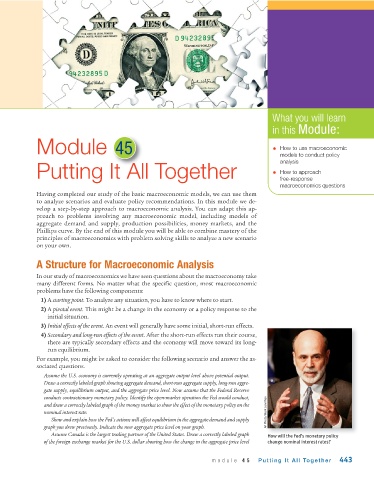Page 485 - Krugmans Economics for AP Text Book_Neat
P. 485
What you will learn
in this Module:
Module 45 • How to use macroeconomic
models to conduct policy
analysis
Putting It All Together • How to approach
free-response
macroeconomics questions
Having completed our study of the basic macroeconomic models, we can use them
to analyze scenarios and evaluate policy recommendations. In this module we de-
velop a step-by-step approach to macroeconomic analysis. You can adapt this ap-
proach to problems involving any macroeconomic model, including models of
aggregate demand and supply, production possibilities, money markets, and the
Phillips curve. By the end of this module you will be able to combine mastery of the
principles of macroeconomics with problem solving skills to analyze a new scenario
on your own.
A Structure for Macroeconomic Analysis
In our study of macroeconomics we have seen questions about the macroeconomy take
many different forms. No matter what the specific question, most macroeconomic
problems have the following components:
1) A starting point. To analyze any situation, you have to know where to start.
2) A pivotal event. This might be a change in the economy or a policy response to the
initial situation.
3) Initial effects of the event. An event will generally have some initial, short-run effects.
4) Secondary and long-run effects of the event. After the short-run effects run their course,
there are typically secondary effects and the economy will move toward its long-
run equilibrium.
For example, you might be asked to consider the following scenario and answer the as-
sociated questions.
Assume the U.S. economy is currently operating at an aggregate output level above potential output.
Draw a correctly labeled graph showing aggregate demand, short-run aggregate supply, long-run aggre-
gate supply, equilibrium output, and the aggregate price level. Now assume that the Federal Reserve
conducts contractionary monetary policy. Identify the open-market operation the Fed would conduct,
and draw a correctly labeled graph of the money market to show the effect of the monetary policy on the
nominal interest rate. AP Photo/Mark Lennihan
Show and explain how the Fed’s actions will affect equilibrium in the aggregate demand and supply
graph you drew previously. Indicate the new aggregate price level on your graph.
Assume Canada is the largest trading partner of the United States. Draw a correctly labeled graph How will the Fed’s monetary policy
of the foreign exchange market for the U.S. dollar showing how the change in the aggregate price level change nominal interest rates?
module 45 Putting It All Together 443

